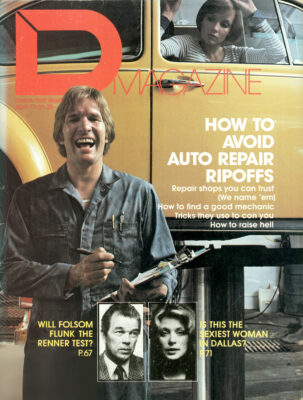Even Paul Osborne himself can’t say exactly what he does. Illusions? Of course. Puppet shows? Dozens. Parades? Yep. Costumed characters? Ditto.
“Right now I’m working on what I call a businessman’s magic kit,” he added. “A customer walks into an office and, poof, the secretary disappears. Or maybe the boss shoves two desks together and suddenly she’s levitating. There are some marketing problems, as you might imagine, but I suspect it will liven up some board meetings.”
Hardly a surprising project for someone who put himself through Northwestern doing magic shows for 50 cents a head, and in the process caught more rotten tomatoes than he cares to recall. After spending several years as director of the Bozo the Clown Training School – “One of my biggest problems was training clowns from places like India and Thailand. You could say there was a large cultural gap.” – Osborne took his last $300 and started his own company, along with artist Hardy Haberman, a Baylor dropout, and Doug Lytton, another Bozo refugee who now manages the careers of Cyrus Cosmo, Merlin Rainbow, and other Osborne characters.
So what pushes a person into this line of work?
“It helps if you’re otherwise unemployable,” replies Hardy, who describes himself as a frustrated Rube Goldberg. “My father was a bacteriologist but I hated bugs so much that I decided to become an archaeologist. It seemed like a nice respectable profession for a dutiful Jewish son. But I discovered I hated dirt and stones even more. At that point it was either learn how to fry chicken or go into show business.”
But not show business as David Merrick might understand it. The characters in Osborne shows are likely to be dancing moose or genial neo-plastoid monsters and the stage a carnival or amusement park. During the year, Osborne may have as many as 15 shows on the road at the same time, each with its own cast and production crews. For Paul, the chance to do live theater regularly compensates for some of the artistic limitations of so-called “family entertainment.”
“Television has become so programmed, so technically flawless, that you never see the unexpected. There’s no vitality and spontaneity anymore. One of the pleasures of doing magic and illusions is the direct engagement with an audience. You also learn rapidly because every performance is so different.
“Kids are always instant script. They’ll usually climb into whatever fantasy you’re projecting. They’ll also fight, scream, throw up, and on occasion even try to use the characters as tackling dummies just to find out who’s inside. And when a character the size of Merlin Rainbow falls down, you’ve got trouble.”
Paul eagerly describes his plans for a new audience-participation seance. Several hundred people are seated in a room. As the medium enters, the temperature drops twenty degrees. There are voices in the walls and mild shock devices in the backs of chairs. A chandelier falls, the medium vanishes, to be replaced by a crow. What happens next is still on the drawing board.
“I’ve always been a toy freak and a cartoon freak,” he remarks. “Saturday morning is still one of the high points of my week. Magic shows are an outlet for my interest in fantasy and gadgetry.”
Related Articles

Arts & Entertainment
Dallas College is Celebrating Student Work for Arts Month
The school will be providing students from a variety of programs a platform to share their work during its inaugural Design Week and a photography showcase at the Hilton Anatole.
By Austin Zook

Basketball
A Review of Some of the Shoes (And Performances) in Mavs-Clippers Game 1
An excuse to work out some feelings.
By Zac Crain

Home & Garden
Past in Present—A Professional Organizer Shows You How To Let Go
A guide to taming emotional clutter.
By Jessica Otte


